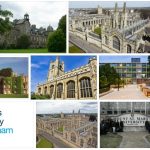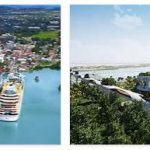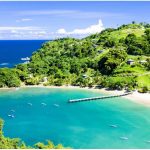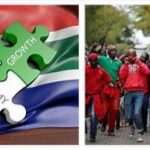Population
The majority of the population are blacks (around 71%) and mulattos (around 23%), mostly descendants of African slaves. About 1% are descendants of Indian contract workers who came to the islands after the abolition of slavery (1834). Whites (mostly of British origin) make up around 2% of the population, around 3% are descendants of the indigenous indigenous population (Caribs). An English coined Creole is common as a colloquial language, on some Grenadines a French coined Creole (patois) is also spoken. The majority of the population lives on the main island of Saint Vincent with the capital Kingstown. The total population density is 282 residents / km 2, the proportion of the urban population is 51%. Due to the prevailing unemployment, many islanders are leaving the country.
Social: The health system is relatively well developed on Saint Vincent, but only patchy on the Grenadines. There are six public and three private hospitals and 39 health centers and posts.
Religion
The constitution guarantees freedom of religion; all religious communities are legally equal. – According to the latest available surveys, over 82% of the population profess Christianity. The majority of them belong to (post-) Reformation religious communities (especially Pentecostals [almost 28%], Baptists [almost 9%], Methodists [less than 9%], and as a separate group the Seventh-day Adventists [less than 12%]), nearly 14% of the Anglican Church (Diocese of Windward Islands of the Province of the West Indies) and over 6% of the Catholic Church (Diocese of Kingstown, suffragan of the Archdiocese of Port of Spain). Rastafaris, Hindus, Muslims, and Baha’is make up numerically small religious minorities. More than 7% cannot be assigned to any religion. Check topschoolsintheusa for higher education in Saint Vincent and the Grenadines.
Business
Saint Vincent and the Grenadines is a member of the Caribbean Community and the Organization of Eastern Caribbean States (OECS). Agriculture, trade and services (including offshore banking) are the most important branches of the economy. With a gross national income (GNI) of (2017) US $ 6,990 per resident, the country is one of the poorer Caribbean countries. Agriculture generates a large part of the export revenues and (2016) contributes 8.3% to the gross domestic product (GDP). The most important export products are bananas and the starch flour of the arrowroot as well as rice. Vegetables, plantains, tubers, coconuts, tobacco and spices are grown for local needs. The processing of agricultural products is the most important branch of industry alongside the textile and electronics industry (share of industry in GDP [2016] 17.6%). Tourism is becoming increasingly important. In 2015, 206,700 guests came (of which 82,100 were cruise passengers). The foreign exchange income from tourism amounted to US $ 95.7 million.
Foreign trade: The trade balance has been negative since the 1980s (imports 2017: US $ 311.3 million, exports: US $ 51.3 million). The main trading partners are the USA, Trinidad and Tobago as well as Barbados and Saint Lucia.
Transportation
The road network of over 1,000 km on the main island of Saint Vincent is not fully developed. The port of Kingstown is the most important transhipment point and at the same time a port of communication with the Grenadines. The Argyle International Airport near Kingstown, which opened in 2013, opens Saint Vincent and the Grenadines to international aviation; the airports of Bequia and Union Island are only of intra-Caribbean importance.
History
Saint Vincent was founded by C. Columbus in 1493discovered; until 1763 the Caribs were able to prevent permanent European settlement. The area came into British possession through the Peace of Paris (1763). The Black Caribs arose from the mixing of escaped slaves with Caribs. In 1795 they rose up with French support; most of them were deported to islands in the Gulf of Honduras (e.g. Roatán) after the uprising was put down (1796); a large part of the remaining Caribs perished in the Soufrière eruptions in 1812 and 1902. In 1871, Saint Vincent joined the Windward Islands as a crown colony. 1958-62 it belonged to the West Indian Federation; In 1969 it received autonomy under the West Indian Associated States. On October 27, 1979, Saint Vincent and the Grenadines became independent as part of the Commonwealth. In 1984 the NDP replaced the SVLP as the ruling party that led Saint Vincent and the Grenadines to independence. Prime Minister was from 1984 to 2000 (as in 1972-74) James Fitzallen Mitchell (* 1931). The 1998 elections were won by the NDP with a narrow majority of the seats, but not the votes. In 2000, as a result of violent protests against government policy, early elections were agreed. Mitchell resigned as party leader and prime minister in favor of Arnhim Eustace (* 1945). The 2001 election was won by the ULP; Prime Minister Ralph Gonsalves (* 1946), who has ruled since then.









